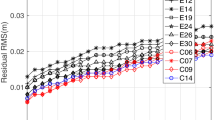Abstract
The information technology developed by the authors to ensure the possibility of operation without downloading information by the ground control complex while improving the accuracy of the ephemerides of the existing global navigation satellite systems (GLONASS) midaltitude segment and its promising additions is described. Achieving the stated goals within the framework of the technology under discussion involves the formation of precise ephemerides by solving the following interrelated tasks: improving the accuracy of determining and predicting the ephemerides of navigation satellites in the inertial coordinate system; improvement of methods and algorithms for forecasting and updating the evolution of the Earth’s rotation parameters onboard satellites; and precise synchronization of onboard clocks. The primary attention is paid to the first of the listed tasks, i.e., prediction and refinement of the ephemerides of navigation satellites in the inertial coordinate system, including in the mode of operation of satellite constellations without updating the ephemerides-temporal information. As a base for its solution, it is proposed to use advanced onboard hardware for intersatellite measurements. The basic limitations related to the implementation of intersatellite measurements and their subsequent processing for both midaltitude and advanced space segments of the GLONASS are discussed. The results of the design-ballistic analysis and processing of real and simulated measurements, as well as the preliminary characteristics of the accuracy of the ephemerides estimates obtained in this case onboard, are presented.











Similar content being viewed by others
REFERENCES
D. M. Kruzhkov and V. V. Pasynkov, High Accuracy Navigation Based on Informational GNSS Technologies. 2. GLONASS—Information Technologies and Navigation Tasks Solving Algorithms (Moscow, MAI, 2021) [in Russian].
D. M. Kruzhkov and V. V. Pasynkov, National Global Navigation Satellite System GLONASS: Features of Creation, Development and Use (Moscow, MAI, 2022) [in Russian].
V. A. Bartenev, A. K. Grechkoseev, D. A. Kozorez, M. N. Krasilchshikov, V. V. Pasynkov, G. G. Sebryakov, and K. I. Sypalo, Modern and Future Informational GNSS Technologies in High-Precision Navigation Tasks (Fizmatlit, Moscow, 2014) [in Russian].
GLONASS Information Analytics Center. https://glonass-iac.ru/. Accessed December 10, 2022.
M. N. Krasil’shchikov and D. M. Kruzhkov, “On the issue of autonomous refining of the Earth orientation parameters onboard spacecraft. Analysis of the possibilities of developed information technology,” Cosmic Res. 59 (5), 357–365 (2021).
A. K. Grechkoseev, M. N. Krasil’shchikov, D. M. Kruzhkov, and T. A. Mararescul, “Refining the Earth orientation parameters onboard spacecraft concept and information technologies,” J. Comput. Syst. Sci. Int. 59 (4), 598–608 (2020).
International Earth Rotation Service. https://www.iers.org/IERS/EN/Home/home_node.html. Accessed December 10, 2022.
Y. Yuguo, N. Wenfeng, X. Tianhe, F. Zhenlong, X. Huijie, and S. Zhangzhen, “Earth orientation parameters prediction based on the hybrid SSA+LS+SVM model,” Meas. Sci. Technol. 33 (12) (2022).
M. N. Krasil’shchikov, D. M. Kruzhkov, and V. V. Pasynkov, “Current problems of improving the coordinate-time support of GLONASS and promising methods for their solution. 1. Alignment of coordinate systems used by various information technologies to refine the geocenter’s position,” J. Comput. Syst. Sci. Int. 58 (4), 648–657 (2019).
O. Montenbruck, P. Steigenberger, and M. Aicher, “A long-term broadcast ephemeris model for extended operation of GNSS satellites,” J. Inst. Navig. 68 (5) (2020).
W. Chen, G. Jing, Z. Qile, and G. Maorong, “Improving the orbits of the BDS-2 IGSO and MEO satellites with compensating thermal radiation pressure parameters,” Remote Sens. 14 (3), 641 (2022).
M. N. Krasilchshikov and G. G. Sebryakov, Modern Information Technologies in the Navigation and Guidance Tasks of Unmanned Maneuverable Aircraft (Fizmatlit, Moscow, 2009) [in Russian].
A. K. Grechkoseev, “Study of observability of motion of an orbital group of navigation space system using intersatellite range measurements. I,” J. Comput. Syst. Sci. Int. 50 (2), 293–308 (2011).
A. K. Grechkoseev, “Study Of Observability Of Motion of An Orbital Group of Navigation Space System Using Intersatellite Range Measurements. II,” J. Computer and Systems Sciences International 50 (3), 472–482 (2011).
W. Chen, Z. Qile, G. Jing, L. Jingan, and C. Gucang, “The contribution of intersatellite links to BDS-3 orbit determination: Model refinement and comparisons,” J. Inst. Navig. 66 (1), 71–82 (2019).
X. Zhao, L. Jinhuo, Z. Shanshi, L. Xiaojie, C. Qiuli, Z. Gong, and W. Haihong, “Research on the Enhancement of BDS-3 constellation orbit determination and ERP by inter-satellite link,” in China Satellite Navigation Conference (CSNC-2022) Proceedings (Beijing, 2022).
E. V. Akimov, D. M. Kruzhkov, and V. A. Yakimenko, “High-precision simulation of onboard signal receivers in global navigation systems,” Russ. Eng. Res. 40 (2), 152–155 (2020).
E. V. Akimov, D. M. Kruzhkov, and V. A. Yakimenko, “Prototype information system for high-precision navigation in global satellite systems,” Russ. Eng. Res. 40 (2), 156–159 (2020).
SVOEVP. http://www.glonass-svoevp.ru/index.php?lang=ru. Accessed December 10, 2022.
D. A. Vallado, Fundamentals of Astrodynamics and Applications (Microcosm Press, Portland, 2022).
D. M. Kruzhkov and V. V. Pasynkov, High-Accuracy Navigation Based on Informational GNSS Technologies. 1. Mathematical Basis (MAI, Moscow, 2021) [in Russian].
Author information
Authors and Affiliations
Corresponding author
Ethics declarations
The authors declare that they have no conflicts of interest.
Additional information
Publisher’s Note.
Pleiades Publishing remains neutral with regard to jurisdictional claims in published maps and institutional affiliations.
Rights and permissions
About this article
Cite this article
Krasilshchikov, M.N., Kruzhkov, D.M., Marareskul, T.A. et al. Improvement of Intersatellite Measurements Scheduling to Refine the Accuracy of the Ephemerides of Modern and Prospective GLONASS Orbital Segments. J. Comput. Syst. Sci. Int. 62, 903–913 (2023). https://doi.org/10.1134/S1064230723050106
Received:
Revised:
Accepted:
Published:
Issue Date:
DOI: https://doi.org/10.1134/S1064230723050106




